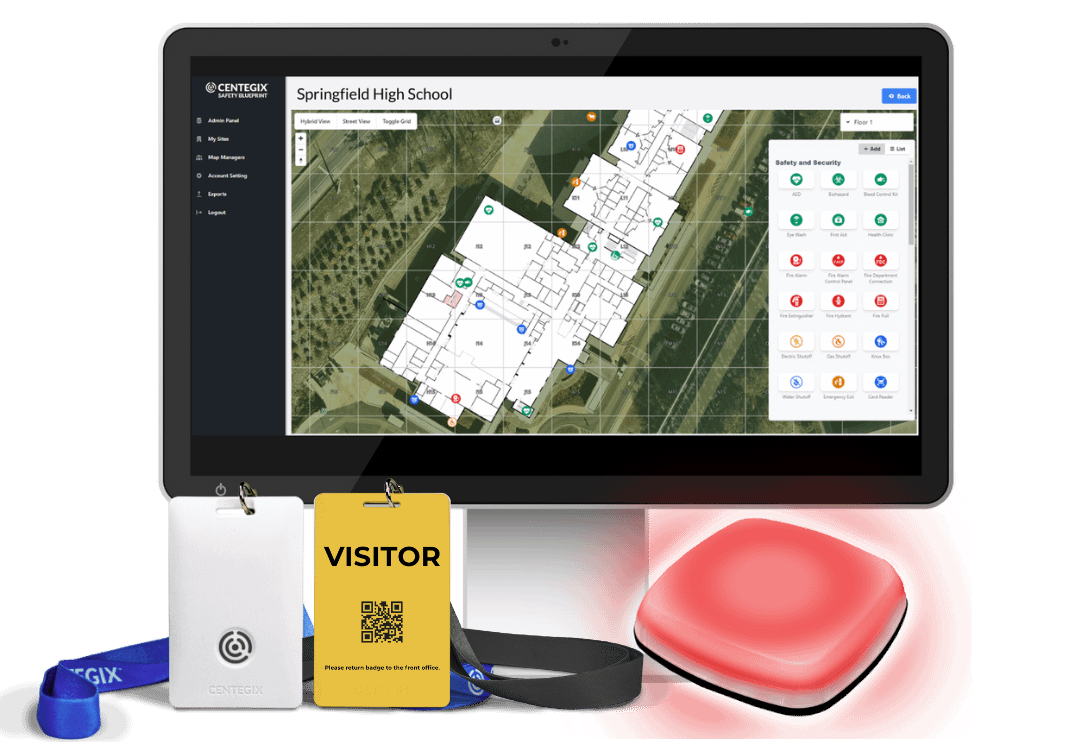Workplace emergencies like medical issues, security threats, and natural disasters are impossible to predict. It’s up to employers to implement safety plans and rapid response protocols to reduce the impact of incidents and support workplace violence prevention.
Establishing response protocols that suit your facility requires a combination of staff training and effective technology. Employees equipped with the skills needed to react in an emergency and tools that reduce response times set the stage for a safe work culture.
Training: The Foundation for Rapid Incident Response
Implementing comprehensive training programs gives employees the knowledge and confidence to react appropriately in an emergency. This is true for healthcare facilities, schools, and government buildings.
Hospitals and clinics have long recognized the importance of education and training as it relates to patient care. Establishing safe patient-handling protocols, training staff on the proper use of equipment, and teaching de-escalation techniques reduce the chance of accidents and emergencies.
For example, healthcare training teaches staff how to anticipate and mitigate risks associated with illnesses such as dementia. These risks include patients becoming stressed and agitated due to cognitive decline. Safety training teaches nurses and healthcare professionals to use empathy and compassion to calm distressed patients and de-escalate situations that could compromise staff and patient well-being.
Healthcare training also supports workplace violence prevention by teaching staff how to recognize the signs of aggressive behavior from patients or family members.
Consider the following approaches to training and education at healthcare facilities:
- Consistently refresh staff on emergency protocols.
- Require ongoing training for patient safety and incident response.
- Designate mentors and peer education champions to support staff on safety procedures.
- Use scenario-based training so staff can practice de-escalation techniques in real time.
Another crucial step in workplace safety is effective incident responsiveness. Establishing protocols helps staff mitigate, respond to, and recover from hazards and threats. Schools use emergency exercises and simulations to train faculty, but these principles are also effective in healthcare facilities and government buildings.
Exercises validate existing emergency plans, programs, policies, roles, responsibilities, and the training curriculum by:
- Familiarizing staff with emergency plans and procedures through low-stress activities.
- Identifying deficiencies and problems in the current emergency program.
- Enhancing collaboration with public information officers and other community partners.
- Strengthening the school’s ability to respond effectively in an emergency.
Reinforcing safety policies and procedures through ongoing training drills allows staff to continuously improve their ability to respond to emergencies.
Municipal buildings are subject to more stringent safety requirements. Government agencies are responsible for investing in municipal safety training, implementing effective policies, and adhering to safety regulation compliance.
Safety training for municipal employees varies by department and job role. For example, police personnel are subject to different safety regulations than office-based employees. Department heads must create training strategies that align with relevant regulations and promote the well-being of employees and city residents.
Training and Technology—Working Together to Save Lives
The technology used for workplace violence prevention has advanced dramatically. When coupled with proactive staff training, facilities have a much better chance of decreasing incidents and improving emergency response times.
The healthcare industry is a perfect example of how valuable technology can be when staff incorporate it into their safety protocols. A rise in threats against healthcare workers has prompted hospitals and medical facilities to implement safety technology and training to help de-escalate conflicts between disgruntled or agitated patients and employees.
Safety technology that’s becoming increasingly common includes:
- Digital alerts that flag patients or visitors with a history of aggressive behavior during the check-in process.
- Wearable duress buttons or panic buttons throughout a facility that help speed emergency response.
- Electronic badges that restrict visitor access to certain areas.
- Cameras and body cameras that allow staff to record aggressive behavior, which often deters the patient or visitor from acting out.
CENTEGIX® combines training and technology to support workplace violence prevention in healthcare facilities, schools, and government buildings. Desktop and intercom takeovers communicate the protocols staff should follow when an alert occurs. With the proper training, employees know what to expect and how to react. Clear communication from a central source of information supports the fastest, most consistent emergency response.
Panic alert buttons now play a significant role in the reduction of response times during school emergencies. Many campuses use CrisisAlert™, a wearable badge featuring a mobile panic button that immediately notifies emergency responders when an incident occurs. These wearable panic buttons also provide fast emergency response in healthcare facilities and government buildings.
Critical incident mapping, such as CENTEGIX Safety Blueprint™, is another essential component of workplace violence prevention. This technology provides a map that shows administrators and emergency responders the precise location of an incident. It also indicates the location of safety assets like first aid kits, fire extinguishers, and evacuation points. This mapping helps healthcare facilities, schools, and government buildings optimize incident response and create effective safety plans.
However, these technologies aren’t enough on their own. They must be combined with staff training to create a partnership between tech and preparedness.
“Routine training to build muscle memory of what to do in an emergency is absolutely necessary to bring the people and the technology together.” – Brent Cobb, CEO, CENTEGIX.
CENTEGIX: Technology that Empowers Staff
When staff is adequately and consistently trained on emergency technologies, they’re able to implement them when it matters. The CENTEGIX Safety Platform™ equips every staff member with a wearable panic button along with the training to know when to use it, how to use it, and what to expect when an alert is initiated.
“My hope is CENTEGIX offers that extra layer to, number one, empower people who saw something that was going on, which then affords the first responders to minimize that response time.” – Jeff Maddox, Superintendent, Worthington City Schools.
CENTEGIX Safety Platform
Every second matters in an emergency. Our Safety Platform supports rapid incident response by setting the foundation of your layered safety plan. It includes an easy-to-use, wearable panic button and dynamic digital mapping. Working together, these technologies minimize the time it takes staff to identify an incident, notify responders, and provide the precise location of the emergency.
CrisisAlert
Effective workplace violence prevention is essential in today’s healthcare industry. Healthcare workers experience five times more workplace violence incidents than employees in other industries.
CrisisAlert is a wearable duress button that gives staff the assistance they need––when they need it. By sending data directly to emergency responders, healthcare professionals can discreetly request help and share their exact location. They can also alert other staff members of an emergency.
“The ability to have that additional sense of safety and security with CrisisAlert gives our staff such a sense of protection and consideration.” – Kala Bettis, Integrated Behavioral Health Supervisor
Safety Blueprint
This intelligent response mapping tool includes a digital blueprint of a facility, including all floors, rooms, staircases, elevators, emergency exits, assembly points, and safety equipment. It allows emergency responders to identify the precise location of an emergency. Safety Blueprint also allows staff to develop safety plans with the help of room-level mapping, which identifies hazards in the workplace.
Training and Tech: The Perfect Team for Workplace Violence Prevention
Effective workplace violence prevention requires a multi-layered approach that includes the right technology and proactive training. Learn how the CENTEGIX Safety Platform can help create a culture of safety in your workplace.












